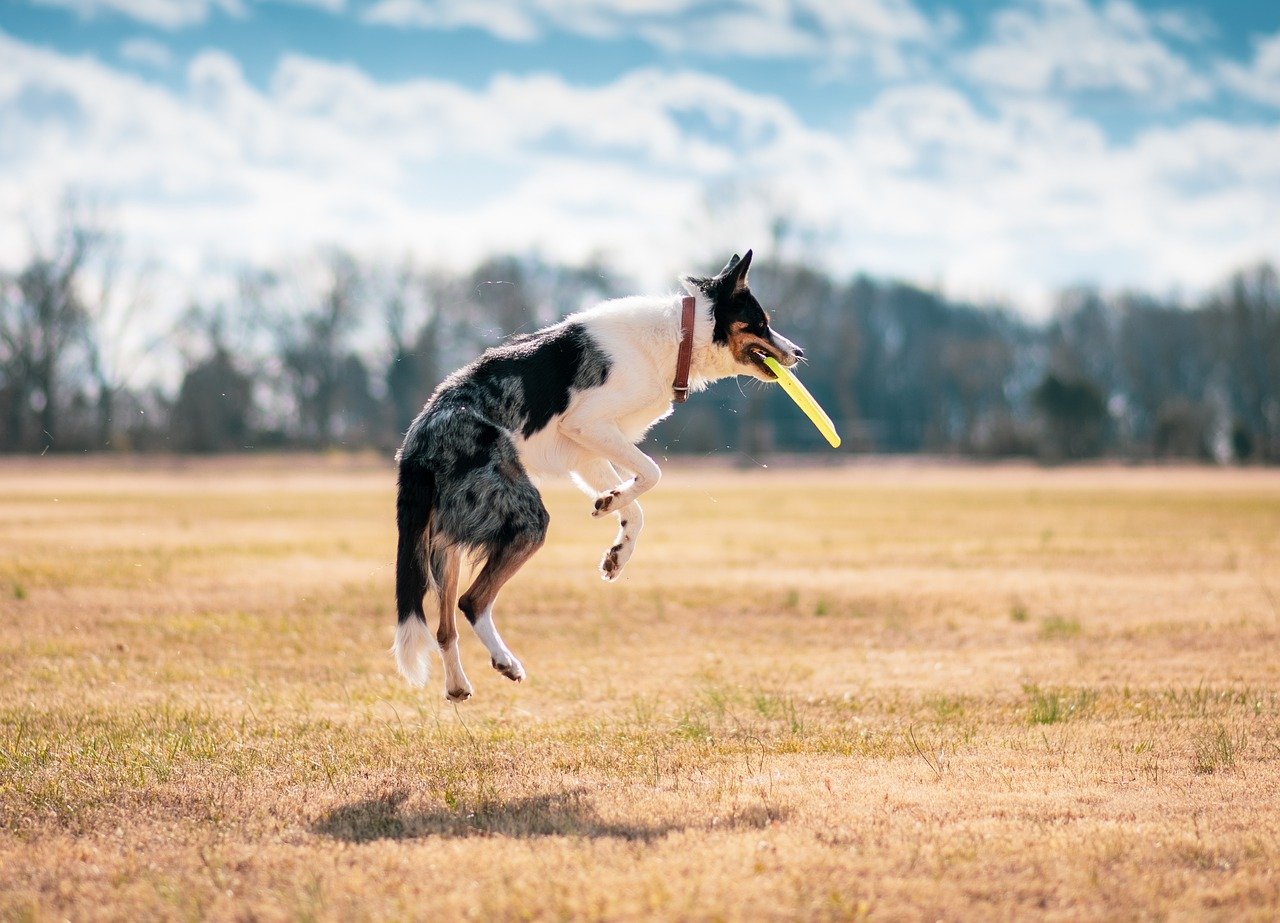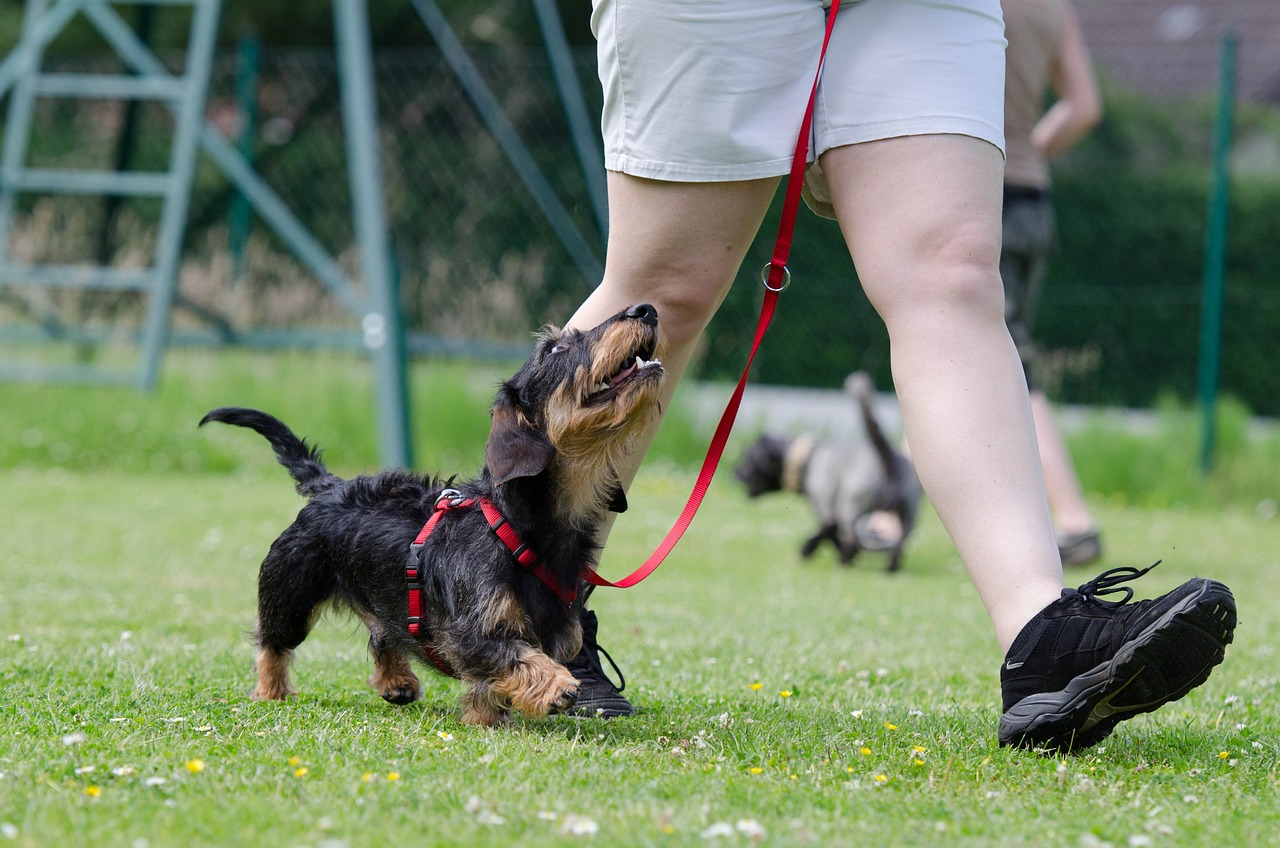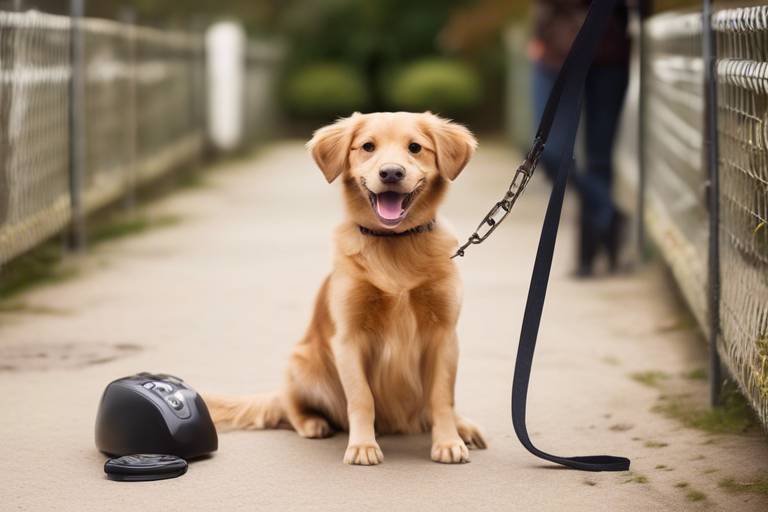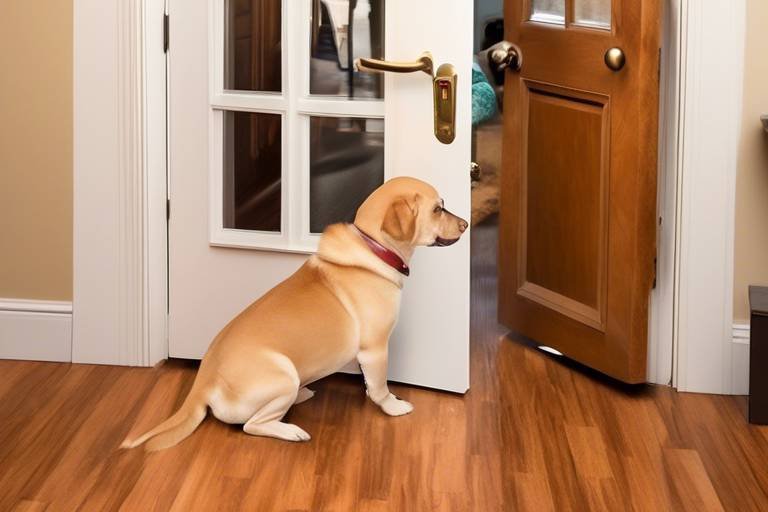How to Help Your Pet Understand Boundaries
As a pet owner, establishing boundaries for your furry friend is not just about keeping your home in order; it’s about fostering a healthy and respectful relationship with your pet. Imagine your home as a cozy little kingdom where both you and your pet can thrive without stepping on each other's toes. Setting boundaries can feel like a daunting task, but with the right approach, it can be a rewarding journey. In this article, we will explore effective strategies to teach your pet about boundaries, ensuring a harmonious relationship between you and your furry friend while promoting their well-being and understanding of limits.
Every pet is unique, with their own personality and quirks. Some pets are naturally more compliant, while others may test your patience. Understanding your pet's individual behavior is crucial. Just like humans, pets have their own language and ways of communicating. By paying attention to their body language and vocalizations, you can better understand their needs and feelings. This understanding lays the groundwork for successful training and communication, making it easier to set clear and effective boundaries.
Establishing boundaries isn't just about saying "no" or "stop." It’s about creating an environment where your pet feels secure and understands what is expected of them. Think of it as drawing a map for your pet. They need to know where they can roam freely and where they should tread carefully. This journey begins with setting clear, consistent rules that you and your pet can follow together.
Consistency is key in training your pet. If one day you allow them on the couch and the next you don’t, it can create confusion and frustration for both of you. It’s like trying to play a game with ever-changing rules; nobody enjoys that! To avoid this, establish a set of rules that you can stick to, and make sure everyone in your household is on the same page. This uniformity helps reinforce learning and builds trust between you and your pet.
Now, let’s talk about the power of positive reinforcement. Using treats, praise, and affection when your pet follows the rules can significantly enhance their understanding of boundaries. For example, if your dog stays off the furniture when asked, reward them with a tasty treat or a good scratch behind the ears. This not only encourages them to repeat the desired behavior but also strengthens your bond. Remember, pets are more likely to respond positively to encouragement rather than punishment.
On the flip side, it’s important to avoid negative reinforcement techniques. Shouting or punishing your pet can lead to fear and anxiety, which can damage your relationship. Instead of fostering understanding, this approach can create a hostile environment where your pet feels insecure. The goal is to teach them boundaries in a loving and compassionate way. After all, our pets rely on us to guide them and keep them safe.
As you embark on this journey, keep an eye out for signs of stress in your pet. Just like us, they can feel overwhelmed or anxious when faced with new situations or rules. Look for signs such as excessive barking, hiding, or changes in appetite. If you notice these signals, it might be time to adjust your training methods. Perhaps take a step back and allow your pet to acclimate to the new boundaries at their own pace.
Creating a safe environment is essential for helping pets learn boundaries. Think of your home as a sanctuary where your pet can explore without fear of reprimand. This means designating specific areas within your home where they can feel secure and understand the limits. For instance, you might create a cozy corner with their bed and toys while keeping certain rooms off-limits. This physical separation can help reinforce the concept of boundaries.
Additionally, utilizing training tools can aid in boundary-setting for pets. There are various tools available, such as gates, leashes, and even training collars, that can assist in effective training practices. These tools can help you establish physical boundaries while providing your pet with the guidance they need to learn and grow. Just like a coach uses specific equipment to train athletes, you can use these tools to help your pet understand their limits.
Q: How long does it take for a pet to learn boundaries?
A: The time it takes varies depending on the pet's age, breed, and temperament. Consistent training and patience are key!
Q: What if my pet doesn’t respond to positive reinforcement?
A: Every pet is different. Try varying the rewards or consider consulting a professional trainer for tailored advice.
Q: Can I set boundaries for multiple pets?
A: Absolutely! Just remember that each pet may require different approaches based on their personalities.
Q: What should I do if my pet shows signs of stress during training?
A: Take a break, reassess your training methods, and ensure that the environment is calm and supportive.

Understanding Animal Behavior
This article explores effective strategies to teach your pet about boundaries, ensuring a harmonious relationship between you and your furry friend while promoting their well-being and understanding of limits.
To effectively set boundaries, it's crucial to comprehend the natural behaviors and instincts of your pet. Just like humans, animals have their own unique ways of communicating and expressing their feelings. For instance, a dog may wag its tail when happy or bark when it feels threatened. Understanding these signals is the first step in establishing a solid foundation for training.
Every pet has its own personality traits, which can influence how they respond to rules. For example, some dogs are naturally more independent and may need a bit more guidance to understand boundaries, while others might be more eager to please and catch on quickly. Recognizing these differences can help you tailor your training methods to suit your pet's individual needs.
Moreover, instinctive behaviors play a significant role in how pets interact with their environment. Cats, for instance, are natural climbers and may see your living room bookshelf as a playground. On the other hand, dogs are pack animals and often look for guidance from their owners. By understanding these instincts, you can create a training plan that resonates with your pet's natural tendencies.
Here are some key behaviors to consider when teaching your pet about boundaries:
- Body Language: Pay attention to how your pet holds its body. A relaxed posture indicates comfort, while a stiff body may signal stress.
- Vocalizations: Different sounds can indicate various emotions; for example, whining might mean anxiety while barking could signal excitement or alertness.
- Play Behavior: Observing how your pet plays can reveal their social skills and boundaries with other animals, which can be a great indicator of how they might respond to your training.
By observing these behaviors, you can better understand your pet's needs and emotions, which will help you communicate boundaries more effectively. Remember, it's not just about teaching them what not to do; it's also about guiding them towards acceptable behaviors. This creates a positive learning environment where your pet feels safe and understood.
In summary, understanding animal behavior is not just about recognizing what your pet does; it’s about interpreting their actions and responding appropriately. By fostering a deeper connection with your furry friend through observation and understanding, you'll set the stage for a successful training journey that promotes respect and well-being.
Defining clear, consistent rules is essential for helping your pet understand what is acceptable. This section discusses how to create and implement these rules effectively.
Consistency is key in training your pet. This subsection emphasizes the importance of maintaining uniformity in rules to avoid confusion and reinforce learning.
Positive reinforcement techniques can significantly enhance your pet's understanding of boundaries. This section covers how rewards can motivate your pet to adhere to established rules.
Negative reinforcement can lead to fear and anxiety in pets. Here, we discuss why it's crucial to avoid this method and focus on positive training techniques.
Understanding your pet's stress signals is vital when teaching boundaries. This section provides insights into identifying these signs to adjust training methods accordingly.
A safe environment is essential for helping pets learn boundaries. This section outlines ways to modify your home and surroundings to support their understanding.
Designating specific areas within your home can help reinforce boundaries. This subsection discusses how to create physical limits that your pet can learn to respect.
Training tools can aid in boundary-setting for pets. This section highlights various tools available and how they can assist in effective training practices.
Q: How long does it take for a pet to learn boundaries?
A: The time it takes varies by pet, but with consistent training, many pets can understand basic boundaries within a few weeks.
Q: Can I use negative reinforcement?
A: It's best to avoid negative reinforcement, as it can lead to fear. Stick to positive methods for better results.
Q: What if my pet doesn’t respond to training?
A: If your pet struggles with training, consider consulting a professional trainer who can provide tailored strategies.

Establishing Clear Rules
Establishing clear rules is like setting the stage for a successful play; without a solid script, things can get chaotic! When it comes to our furry companions, having a well-defined set of rules is essential for teaching them what is acceptable behavior. Think of it this way: just as children need boundaries to feel secure and understand expectations, pets thrive in an environment where they know what’s allowed and what’s not. So, how can we create these clear rules? It starts with consistent communication and a shared understanding between you and your pet.
First and foremost, it’s crucial to define the rules you want to implement. Are there certain areas of the house that are off-limits? Do you want your pet to refrain from jumping on furniture? These rules must be clear in your mind before you can effectively communicate them to your pet. Once you’ve established your rules, it’s essential to communicate them consistently. Every family member should be on the same page to avoid sending mixed signals. For example, if you don’t want your dog on the couch, but one family member allows it occasionally, this confusion can lead to frustration for both you and your pet.
Another important aspect is to ensure that the rules are realistic and achievable. Setting overly strict or unrealistic expectations can lead to frustration on both sides. Instead, consider what is reasonable for your pet’s age, breed, and temperament. For instance, if you have a puppy, it's unrealistic to expect them to be perfectly house-trained in a week. Instead, focus on incremental goals, like teaching them to go outside after meals.
- Define your rules clearly: Make sure you know what behaviors you want to encourage or discourage.
- Communicate consistently: Everyone in the household should enforce the same rules.
- Be realistic: Understand your pet’s abilities and set achievable goals.
Once the rules are established, it’s time to implement them in a way that is engaging for your pet. This is where the magic of training comes into play! Use commands and cues consistently, so your pet learns to associate specific behaviors with your expectations. For example, if you want your dog to stay off the couch, use a clear command like “off” every time they jump up. Reinforce this command with positive reinforcement, such as treats or praise, when they comply. Over time, your pet will begin to understand that certain behaviors lead to positive outcomes, which will help solidify their understanding of the rules.
Remember, patience is key! Teaching your pet about boundaries is a journey, not a race. Celebrate small victories along the way, and don’t get discouraged by setbacks. Each interaction is an opportunity to reinforce the rules you’ve set, paving the way for a more harmonious relationship between you and your furry friend. In the end, a well-behaved pet is a happy pet, and that happiness will reflect in your shared experiences!
Consistency in Training
When it comes to training your pet, consistency is not just a buzzword; it's the cornerstone of successful behavior modification. Imagine trying to learn a new language where the rules change every day. Frustrating, right? That’s exactly how your pet feels if the training rules are inconsistent. To establish a solid understanding of boundaries, you must ensure that everyone in your household is on the same page. This means that whether it’s you, your partner, or your kids, everyone needs to apply the same rules and use the same commands.
To achieve this, consider establishing a set of clear guidelines that everyone agrees upon. For instance, if you decide that your pet is not allowed on the couch, then that rule must be upheld by all family members. If one person allows the pet on the couch while another scolds them for it, your furry friend will become confused and may even develop behavioral issues. Consistency helps your pet to understand expectations and builds trust between you and your furry companion.
Furthermore, consistency extends beyond just rules; it also applies to the timing and method of rewards. If you’re using treats as a form of positive reinforcement, make sure to reward your pet immediately after they exhibit the desired behavior. This immediate feedback reinforces the action in their mind. If you wait too long, your pet might not connect the treat with the behavior you want to encourage. Think of it like a game: the quicker you reward your pet for a good play, the more likely they are to play that way again!
Here are some tips to help maintain consistency in your training efforts:
- Unified Commands: Use the same words and phrases for commands. For example, if you say "sit," everyone should use that exact word instead of variations like "sit down" or "sit please."
- Reinforce with the Same Rewards: Use the same type of treats or praise. If one person uses treats and another uses toys, it can confuse your pet.
- Regular Training Sessions: Schedule regular training sessions to keep your pet engaged and learning. Consistency in timing is just as important as consistency in rules.
By following these simple yet effective strategies, you can create a training environment that is not only consistent but also enjoyable for both you and your pet. Remember, training should be a fun experience that strengthens your bond, so keep it light-hearted and rewarding!
Using Positive Reinforcement
When it comes to teaching your pet about boundaries, positive reinforcement is one of the most effective tools in your training toolbox. Imagine this: you’re trying to teach a toddler not to touch the hot stove. Would you yell at them every time they reached for it? Of course not! Instead, you’d guide them away and reward them when they play safely. The same principle applies to our furry friends. By using rewards, you create a positive association with the desired behavior, making it more likely that your pet will repeat it.
So, how do you implement positive reinforcement with your pet? First, identify what motivates them. For some pets, it might be their favorite treat, while others may respond better to verbal praise or playtime. Once you know what makes their tail wag or their ears perk up, you can use these motivators effectively. For example, if your dog stays in a designated area without wandering off, immediately offer a treat and a cheerful “Good boy!” This not only reinforces the behavior but also strengthens your bond.
It's essential to be consistent with your rewards. If you only reward your pet sometimes, they may become confused about what behavior is being reinforced. Think of it like a game: if your pet doesn’t know the rules, how can they win? The key is to reward them every time they exhibit the desired behavior, especially during the initial training phase. Over time, as they learn and understand the boundaries, you can gradually reduce the frequency of rewards.
Another important aspect of positive reinforcement is timing. The reward should come immediately after the desired behavior. This way, your pet can make the connection between their action and the reward. For instance, if your cat uses the scratching post instead of the couch, give them a treat right after they scratch the post. This immediate feedback helps them learn faster and more effectively.
Remember, patience is vital. Not every pet learns at the same pace, and some may take longer to grasp the concept of boundaries. Celebrate the small victories along the way. If your pet is making progress, even if it’s just a little bit, give them a pat on the back (or a scratch behind the ears) to encourage them to keep going. With time, love, and the right approach, you’ll find that your pet will understand their boundaries much better.
In conclusion, positive reinforcement is not just about giving treats; it’s about creating a loving and supportive environment where your pet feels safe to learn. By focusing on the good behaviors and rewarding them, you’ll foster a relationship built on trust and understanding. So, the next time you’re training your pet, remember: a little praise and a tasty treat can go a long way!
- What is positive reinforcement? Positive reinforcement is a training method that involves rewarding desired behaviors to encourage their repetition.
- How do I know what motivates my pet? Observe your pet's reactions to different stimuli, such as treats, toys, or praise, to determine what they respond to best.
- Can I use positive reinforcement for all pets? Yes! Positive reinforcement can be effective for a wide variety of pets, including dogs, cats, and even small animals like rabbits.
- What if my pet doesn’t respond to rewards? If your pet isn’t motivated by treats or praise, try experimenting with different types of rewards or consult a professional trainer for guidance.
Avoiding Negative Reinforcement
When it comes to training your pet, the methods you choose can make a world of difference in their behavior and overall well-being. One approach that should be avoided at all costs is negative reinforcement. This technique involves applying an unpleasant stimulus to discourage unwanted behavior, but it often leads to more harm than good. Imagine if every time you made a mistake at work, your boss yelled at you. Wouldn't that create a stressful environment? The same goes for our furry friends.
Negative reinforcement can lead to fear, anxiety, and even aggression in pets. Instead of fostering a positive learning environment, it can make your pet associate certain actions with discomfort. For example, if you scold your dog for jumping on the couch, they might become fearful of the couch itself rather than understanding that jumping is the issue. This fear can manifest in various ways, such as hiding, excessive barking, or even destructive behavior. It's essential to recognize that our pets thrive in environments where they feel safe and secure.
So, what can you do instead? Focus on positive reinforcement, which encourages good behavior through rewards and praise. This method not only helps your pet learn but also strengthens the bond between you. For instance, when your dog sits calmly instead of jumping on the couch, reward them with a treat or verbal praise. This reinforces the idea that good behavior is rewarding, making them more likely to repeat it in the future.
Here are some reasons why avoiding negative reinforcement is crucial:
- Builds Trust: Positive reinforcement fosters a trusting relationship, making your pet feel safe and loved.
- Encourages Learning: Pets learn better in a positive environment, where they associate good behavior with rewards.
- Reduces Stress: A stress-free pet is a happy pet. Avoiding negative reinforcement minimizes anxiety and fear.
In conclusion, while it might be tempting to use negative reinforcement when your pet misbehaves, it's essential to remember that this approach can have lasting negative effects. Instead, embrace methods that promote understanding and kindness. By focusing on positive reinforcement, you're not just teaching your pet boundaries; you're also creating a loving and supportive environment that benefits both of you!
Q: What is negative reinforcement?
A: Negative reinforcement is a training method that involves applying an unpleasant stimulus to discourage unwanted behavior. It can lead to fear and anxiety in pets.
Q: Why should I avoid negative reinforcement?
A: Negative reinforcement can create a stressful environment for your pet, leading to fear, anxiety, and even aggression. It's more effective to use positive reinforcement.
Q: What is positive reinforcement?
A: Positive reinforcement is a training method that rewards good behavior with treats, praise, or affection, encouraging your pet to repeat those behaviors.
Q: How can I implement positive reinforcement?
A: You can implement positive reinforcement by rewarding your pet immediately after they exhibit desirable behavior, such as sitting calmly or following commands.
Recognizing Signs of Stress
Understanding your pet’s emotional state is crucial when teaching them about boundaries. Just like humans, pets can experience stress, and it’s essential to recognize the signs early to prevent any negative impacts on their well-being. Imagine trying to learn a new skill while feeling overwhelmed; it’s pretty challenging, right? Similarly, when pets are stressed, they might struggle to grasp the boundaries you are trying to set. So, what should you look for?
First, pay attention to body language. A pet that is anxious may exhibit behaviors such as:
- Tucked tails - A dog with a tucked tail is often scared or submissive.
- Flattened ears - Ears that are pinned back can indicate discomfort or fear.
- Excessive panting - This can be a sign of stress, especially if it occurs without physical exertion.
- Hiding or retreating - If your pet is seeking solitude, they may be feeling overwhelmed.
Next, consider their vocalizations. Dogs may bark excessively, while cats might meow more than usual. These vocal changes can signal that your pet is feeling stressed. Just like a person might raise their voice when upset, your furry friend might do the same. Additionally, keep an eye on their eating habits. A sudden loss of appetite or changes in their eating routine can indicate stress. If your pet is normally a food lover and suddenly turns their nose up at their favorite meal, it might be time to investigate further.
Another critical aspect to consider is their activity level. An increase in destructive behavior, such as chewing furniture or scratching at doors, can indicate that your pet is feeling anxious. It’s their way of expressing frustration or trying to cope with stress. On the flip side, lethargy can also be a sign of stress, as pets may withdraw and become less active when they’re not feeling well emotionally.
To help you better understand these signs, here’s a quick reference table:
| Sign of Stress | Possible Interpretation |
|---|---|
| Tucked tail | Fear or submission |
| Flattened ears | Discomfort or anxiety |
| Excessive panting | Stress or overheating |
| Hiding | Overwhelm or fear |
| Destructive behavior | Frustration or anxiety |
Recognizing these signs is the first step in creating a supportive environment where your pet can learn and thrive. If you notice any of these signs, it might be beneficial to adjust your training methods temporarily. Just like we sometimes need a break when we’re stressed, your pet might need some time to relax and regain their composure. By being attuned to their emotional needs, you can foster a more effective learning atmosphere, allowing your pet to understand boundaries without the added pressure of stress.
Q: How can I tell if my pet is stressed?
A: Look for signs such as changes in body language, vocalizations, eating habits, and activity levels. Common signs include a tucked tail, flattened ears, excessive panting, hiding, and destructive behavior.
Q: What should I do if my pet shows signs of stress during training?
A: If you notice your pet is stressed, consider taking a break from training. Allow them some time to relax and adjust. You can also modify your training approach to make it more comfortable for them.
Q: Can stress affect my pet's health?
A: Yes, prolonged stress can lead to various health issues in pets, including anxiety disorders, digestive problems, and weakened immune systems. It's essential to manage their stress levels effectively.

Creating a Safe Environment
When it comes to teaching your pet about boundaries, creating a safe environment is absolutely crucial. Just like a child learns best in a nurturing space, your furry friend will thrive in an area that is free from hazards and distractions. Imagine your home as a sanctuary for your pet, where they can explore, play, and learn without the stress of potential dangers lurking around every corner. So, how do you go about crafting this safe haven?
First and foremost, it's vital to remove hazards. Pets are naturally curious creatures, and they tend to investigate their surroundings. This means you need to be proactive in eliminating anything that could pose a risk. For instance, keep toxic plants, chemicals, and small objects that could be swallowed out of reach. You might also want to consider using baby gates to block off areas that are off-limits, effectively establishing a physical boundary that your pet can learn to respect.
Next, think about the layout of your home. Designating specific areas for different activities can help your pet understand where they can and cannot go. For example, if you want your pet to stay out of the kitchen while you're cooking, create a cozy spot in the living room with their favorite toys and a comfy bed. This way, they’ll have their own space to relax while you handle the cooking duties. It’s all about giving them a sense of belonging while also teaching them boundaries.
Another important aspect of creating a safe environment is the use of training tools. These tools can be incredibly beneficial in reinforcing the boundaries you’ve established. Consider using items like:
- Crates: A crate can serve as a safe space for your pet, where they can feel secure and calm.
- Leashes: When going outside, a leash not only keeps your pet safe but also helps them learn about boundaries in a larger environment.
- Training collars: These can provide gentle reminders about boundaries without causing distress.
Moreover, consider the importance of socialization. Introducing your pet to various environments and situations can help them learn to navigate boundaries in a safe manner. Whether it’s meeting new people or encountering other pets, socialization teaches them how to behave appropriately. Just like humans, pets need to learn the rules of engagement, and this is best done in a controlled and safe environment.
Finally, remember that your pet will look to you for cues. They are incredibly perceptive and can sense your emotions and reactions. By maintaining a calm and positive demeanor, you can help your pet feel secure and confident in their surroundings. This confidence is essential for them to learn and respect the boundaries you’ve set. After all, a pet that feels safe is more likely to thrive and adhere to the rules you establish.
Q: How can I tell if my pet feels safe in their environment?
A: Look for signs of relaxation, such as a wagging tail, playful behavior, and a calm demeanor. If your pet seems anxious or fearful, it’s essential to reassess their environment.
Q: What should I do if my pet doesn't respect boundaries?
A: Consistency is key! Reinforce the rules with positive reinforcement and ensure that all family members are on the same page regarding the rules you’ve set.
Q: How can I make my home more pet-friendly?
A: Remove hazards, designate safe areas, and consider using training tools to help your pet understand their boundaries better.
Designating Boundaries in the Home
Creating a harmonious living space for both you and your pet starts with designating clear boundaries within your home. Think of your home as a canvas where you can paint the rules of engagement for your furry friend. By establishing specific areas where your pet is allowed and areas that are off-limits, you can help them understand their space. This not only promotes a sense of security for your pet but also prevents potential conflicts and accidents.
To begin, consider the layout of your home. Are there rooms that your pet frequently enters but shouldn’t? Perhaps your bedroom is a sanctuary that you want to keep pet-free, or maybe the kitchen is a bustling area where you don't want your pet to interfere. Whatever the case may be, it’s essential to communicate these boundaries clearly. You can use baby gates or pet barriers to physically restrict access to certain areas. This is akin to putting up a 'Do Not Enter' sign; it creates a visual cue that your pet can learn to recognize.
Another effective method is to use designated pet zones. Choose specific areas where your pet is allowed to roam freely, such as a cozy corner in the living room or a designated space in the backyard. This not only gives your pet a sense of ownership but also reinforces the idea of boundaries. You might want to create a comfortable bed or play area in these zones, making them inviting and appealing. Remember, the goal is to create a positive association with these designated spaces.
Furthermore, consistency is crucial when it comes to boundaries. If you allow your pet in certain areas sometimes but not others, it can lead to confusion. Imagine trying to follow a game with constantly changing rules; it would be frustrating, right? To avoid this, establish a clear set of rules that everyone in the household agrees upon. Make sure that all family members are on the same page regarding where the pet is allowed and where they are not. This unified approach will help your pet feel more secure and understand their limits.
Additionally, it’s important to monitor your pet’s behavior in these designated areas. If they seem anxious or unsure, it may be a sign that the boundaries need to be adjusted. For instance, if your dog is constantly scratching at the gate to get into the kitchen, it might be worth reconsidering whether that boundary is appropriate. Flexibility is key; sometimes, boundaries need to be re-evaluated based on your pet’s needs and behaviors.
In conclusion, designating boundaries in your home is a fundamental step in teaching your pet about limits. By creating clear physical and emotional spaces, you not only enhance your pet's understanding but also foster a loving and respectful relationship. Remember, boundaries are not just rules; they are a way to ensure that your home is a safe haven for both you and your furry companion.
- How can I tell if my pet understands the boundaries? Look for signs of compliance, such as your pet staying in designated areas and not trying to access restricted zones.
- What should I do if my pet repeatedly breaches boundaries? Reassess the training methods you are using and consider reinforcing the boundaries with positive rewards or additional training tools.
- Are there specific areas that should always be off-limits? Yes, areas like kitchens and bedrooms are often best kept pet-free to maintain hygiene and personal space.
Utilizing Training Tools
When it comes to teaching your pet about boundaries, utilizing the right training tools can make all the difference. Think of these tools as your training allies, designed to enhance communication and reinforce the lessons you want your furry friend to learn. Just like a painter needs brushes and colors to create a masterpiece, you need effective tools to shape your pet’s understanding of their limits.
First and foremost, it's essential to recognize that different pets may respond better to different tools. For example, while some dogs thrive on clicker training, others may find success with treat-based rewards. The key is to experiment and find what resonates best with your pet's personality. Here are some popular training tools that can help:
- Clickers: A small handheld device that makes a distinct sound when pressed. It’s a great way to mark desired behaviors instantly, making it clear to your pet what they did right.
- Treats: High-value treats can motivate your pet to follow commands and respect boundaries. Choose something special that your pet doesn’t get every day to make training more exciting.
- Leashes and Harnesses: These are essential for teaching outdoor boundaries. A good leash or harness can help you control your pet while they learn to respect the limits you set.
- Training Mats: Designating a specific mat for your pet can help them understand where they are allowed to be. This is especially useful for teaching them to stay in one place when guests arrive.
Moreover, technology has made its way into pet training as well. Consider using apps that offer training tips and track your pet's progress. There are also interactive toys that can keep your pet engaged while reinforcing boundary concepts through play. For instance, puzzle toys can be used to reward your pet for staying within certain areas of your home, thus combining fun with learning.
It's crucial to remember that the effectiveness of these tools hinges on your approach. Using them consistently and positively will yield the best results. For example, if you decide to use a clicker, make sure to click and treat immediately when your pet exhibits the desired behavior. This instant feedback helps solidify their understanding of what is expected.
In conclusion, the right training tools can significantly enhance your pet's learning experience. They not only provide a structured way to teach boundaries but also make the process enjoyable for both you and your furry companion. So, equip yourself with these tools, stay patient, and watch as your pet begins to grasp the concept of boundaries in no time!
Q: How long does it usually take for a pet to learn boundaries?
A: The time it takes for a pet to learn boundaries varies widely depending on the individual pet, their age, and the consistency of training. Generally, with regular practice, you can expect to see progress within a few weeks.
Q: Can I use training tools for both dogs and cats?
A: Yes, many training tools can be adapted for use with both dogs and cats. However, it’s essential to tailor your approach to each species' unique behaviors and instincts.
Q: What should I do if my pet seems stressed during training?
A: If you notice signs of stress, such as excessive panting or hiding, take a step back. Reduce the intensity of the training sessions and ensure that your pet feels safe and comfortable. Consider consulting a professional trainer if the stress persists.
Q: Are there any tools I should avoid?
A: Avoid tools that rely on punishment or negative reinforcement, as these can create fear and anxiety in your pet. Instead, focus on positive reinforcement tools that encourage good behavior.
Frequently Asked Questions
- How can I tell if my pet understands the boundaries I've set?
It's often a mix of observation and patience. Look for signs like following commands, staying within designated areas, and responding positively to your cues. If your pet seems relaxed and not anxious, it's a good indicator that they understand and respect the boundaries.
- What should I do if my pet keeps breaking the rules?
First, don’t lose hope! It’s crucial to revisit your training methods. Ensure you're being consistent and using positive reinforcement. Sometimes, pets need a little extra time or a different approach to fully grasp the rules. Consider breaking down the boundaries into smaller, more manageable steps.
- Are there specific signs of stress I should watch for in my pet?
Absolutely! Common signs include excessive barking, hiding, pacing, or changes in eating habits. If you notice any of these behaviors, it might be time to tweak your training approach. Remember, a stressed pet can lead to confusion about boundaries, so it’s essential to keep things calm and positive.
- How can I effectively use positive reinforcement?
Positive reinforcement is all about rewarding good behavior. This could be treats, praise, or playtime when your pet follows a command or respects a boundary. The key is to reward them immediately after the desired behavior so they can make the connection between the action and the reward!
- Can negative reinforcement ever be beneficial for training?
Generally, it's best to avoid negative reinforcement. While some might think it can be effective, it often leads to fear and anxiety, which can hurt the bond between you and your pet. Focus on positive methods to encourage good behavior instead; they lead to a happier and more trusting relationship.
- How do I create a safe environment for my pet?
Start by assessing your home for potential hazards. Remove anything that could harm your pet and designate specific areas where they can safely play and relax. Using baby gates or pet barriers can also help establish physical boundaries, making it easier for your pet to understand where they can and cannot go.
- What training tools are most effective for boundary-setting?
There are several great tools you can use! Leashes, harnesses, and training collars can help reinforce boundaries during walks. Additionally, items like clickers can aid in training by providing a clear signal when your pet behaves correctly. Just remember to pair these tools with positive reinforcement for the best results!



















